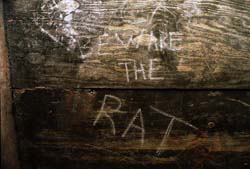Get to know Seattle from the inside on the Underground Tour
The Seattle Underground is a network of underground passageways and basements in downtown Seattle that was ground level at the city's origin in the mid-19th century. After the streets were elevated these spaces fell into disuse, but have become a tourist attraction in recent decades.
Seattle's first buildings were wooden. In 1889, a cabinetmaker accidentally overturned and ignited a glue pot. An attempt to extinguish it with water spread the burning grease-based glue. The fire chief was out of town, and although the volunteer fire department responded they made the mistake of trying to use too many hoses at once. They never recovered from the drop in water pressure, and the Great Seattle Fire destroyed 25 city blocks.
Instead of rebuilding the city as it was before, city leaders made two strategic decisions: that all new buildings must be of stone or brick (so they would not burn down in another fire); and to regrade the streets one to two stories higher than the original street grade. Pioneer Square had originally been built mostly on filled-in tidelands and, as a consequence, it often flooded. The new street level also assisted in ensuring that gravity-assisted flush toilets that funneled into Elliott Bay did not back up at high tide.
Once the new sidewalks were complete, building owners moved their businesses to the new ground floor, although merchants carried on business in the lowest floors of buildings that survived the fire, and pedestrians continued to use the underground sidewalks lit by the glass cubes (still seen on some streets) embedded in the grade-level sidewalk above.
In 1907 the city condemned the Underground for fear of pneumonic plague. The basements were left to deteriorate or were used as storage. Only a small portion of the Seattle Underground has been restored and made safe and accessible to the public on guided tours.
In 1965, local citizen Bill Speidel realized there might be interest (and profit) in the subterranean ruins. He established "Bill Speidel's Underground Tour" and took customers on a tour of what was left underneath Pioneer Square, paying rent to the building owners for the privilege of doing so. He peppered his tour with tall tales from Seattle's history (some more factual than others), giving the tour an amusing counterculture feel that made it an "underground" tour in every sense of the word.
Over the years the tour has become more popular, and the underground structures have been steadily refurbished to be more visually appealing. The tour remains a popular attraction for visitors and locals alike.
Here's what you'll see:
The Seattle Underground tour is more than just a tour of a few blocks of underground ruins. The tour guides tell some great stories about the colorful history of Seattle. These stories give you a good background on the somewhat shady past of the city. You will want to budget a couple of hours for this tour:
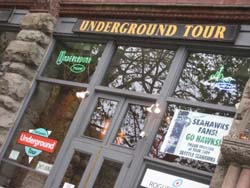
The tour starts right in historic Pioneer square which is very close to the waterfront and within walking distance to the ferry terminal. The Underground Tour is easy to get to and right in the core of the city.
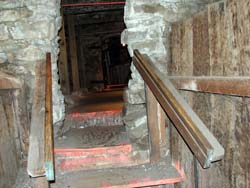
After a brief introduction, you'll descend a flight of stairs and find yourself in a world that was left behind and built on top of. It's an easy walk because the tour maintains boardwalks and stairs throughout the tour.

You'll see lots of abandoned artifacts from the 19th century, including signs, bathrooms, tubs, cash registers, and much more.
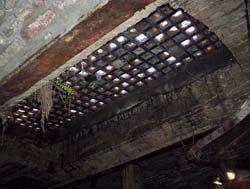
If you look up, you will see glass grates that let light into the underground. This same glass is embedded into the sidewalks and can be seen underfoot as you walk the streets around Pioneer Square.
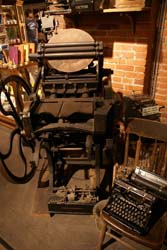
At the end of the tour, you can look through a small museum and gift shop. Many 19th century artifacts have been restored and are on display there. You can also get more information about the colorful stories and people that you started to learn about on the tour.


